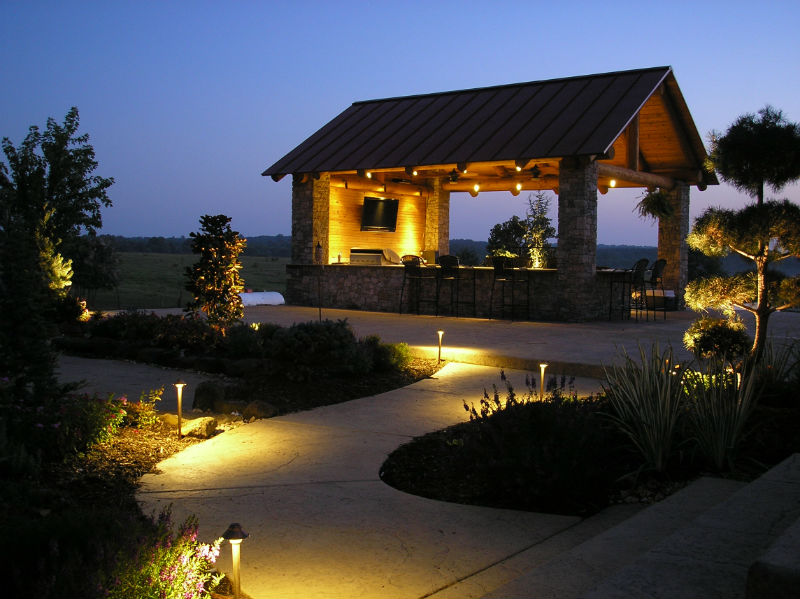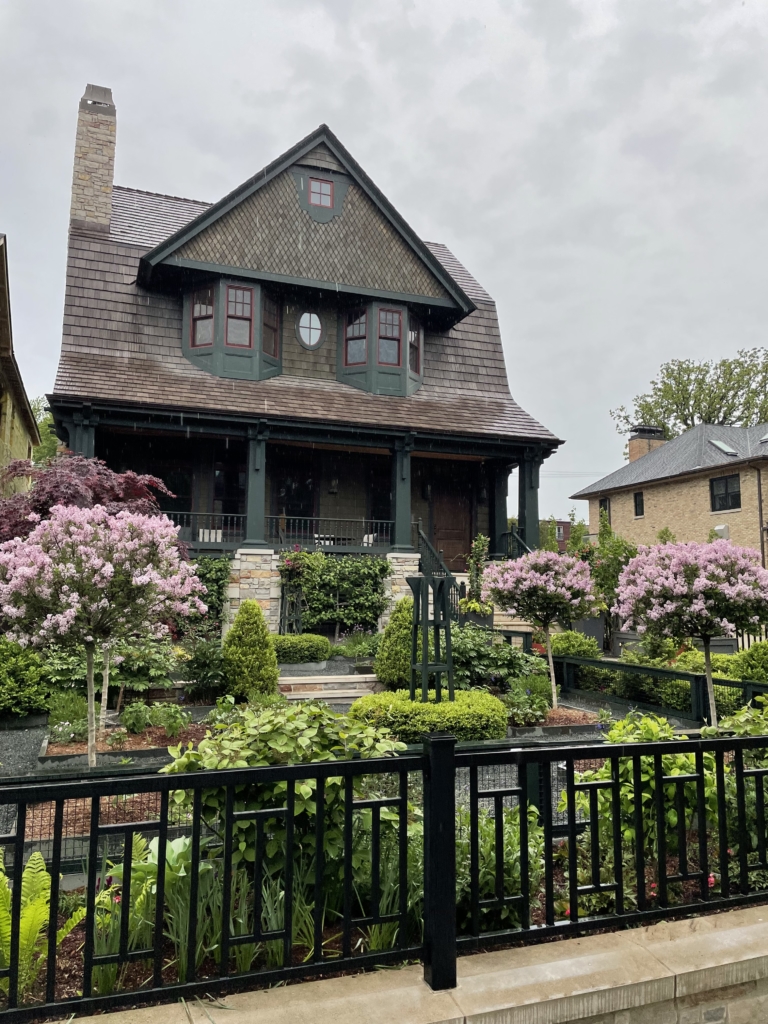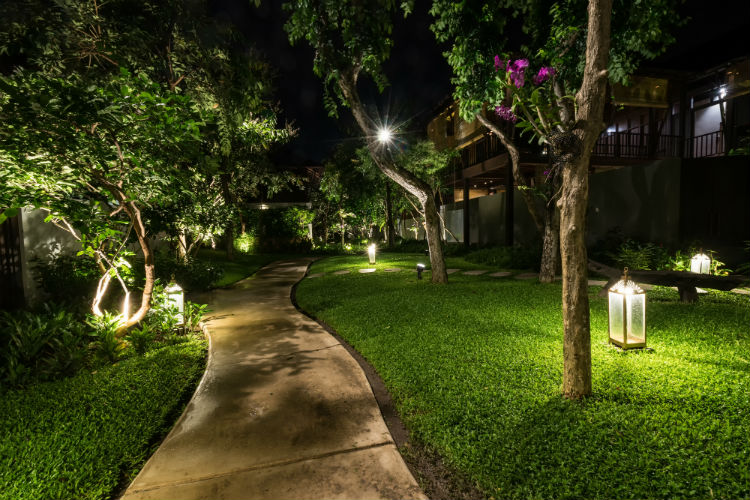
More than illuminating elements in the landscape, professional landscape lighting is designed to achieve specific lighting outcomes.
These outcomes may include leading people safely to their destination, creating interesting shadows, or providing a sense of pause or motion to influence activities and behaviors.
All of this is accomplished with techniques used by songwriters. A musical composition involves working with musical notes, chord combinations, and the spaces between them.
The spaces between the notes are intentional. They are used the same way darkness is used to punctuate outdoor lighting to create visual effects. If they are not used properly, the light from multiple fixtures merges to create visual noise.
Let’s look at the techniques landscape lighting professionals use to delight and surprise those who enjoy the night as much as daytime.
#1. Weather Influences
Achieving optimum landscape lighting outcomes requires an understanding of how light affects color balance. For example, there are many reasons why photographers try to avoid midday sunlight.
- The light is harsh
- There are no shadows
- Colors are washed out
- There’s too much reflection
- There can be blind spots
Photographers know that colors change throughout the day due to factors such as humidity and temperature gradients. The same is true for natural moonlight and artificial nighttime lighting.
The nighttime landscape is an opportunity for playing with the light that suits more relaxed activities appropriate for that time of day. You can turn up the light to have truer hues, but most people tend to enjoy a balanced canvas.
Even color experts are surprised at what happens when lighting blends and complementary and contrasting color combinations. The only way to get the right mix is by applying color principles and testing strategic lighting scenarios. to discover what works best.
#2. Movement Fundamentals
While lighting can sometimes be difficult, water is a favorite for creating movement in the nighttime landscape. Ripples in reflecting pools and ponds are softly illuminated by full moonlight. Supplemental landscape lighting can be designed to accentuate this effect.
Another type of movement is achieved with ornamental grasses such as Calamagrostis x acutiflora ‘Karl Foerster.’ This durable 4-5′ perennial grass thrives in our climate.
It offers exceptional winter interest, including movement with even the most gentle breeze. Warm, low-voltage lighting will capture that movement, further emphasizing it when seed frosted with ice or light snow sparkle in the light.
Repetition is a design principle employed for creating movement in the landscape. While many trees have rounded canopies, some have distinctive shapes, such as the pyramidal form of Pin Oaks and some Hollies.
The staccato pattern of pyramidal shapes can punctuate the nighttime landscape with uplighting. This effect can be enhanced by planting masses of white flowering shrubs such as Hydrangeas at their base.
It only takes a light touch to illuminate white flowering plants. For a full-season effect, masses of perennials with white foliage, such as Artemesias and Stachys, work beautifully.
#3. Formal and Informal Themes

Lines are among the most powerful landscape design elements because whether they are curved or linear, our eye naturally follows them.
Geometric shapes and linear patterns populate formal designs, with curvilinear shapes and lines dominating informal landscape designs.
A central element or grouping of elements in a formal landscape design, such as that in the photo above, will pop out when properly lighted.
The alternative is to de-emphasize these stronger elements by placing more emphasis on the frame, a perimeter hedgerow, for example.
It all depends on how you wish to experience the space. If you want to relax in your outdoor living space after sunset, it makes sense to illuminate the perimeter so that you can enjoy your privacy.
This lighting can be especially dramatic with larger properties. Balanced lighting that anchors elements to the property during the evening hours creates interesting views around every corner.
In contrast, elegantly lighting formal elements that are central to the property is an elegant way to subtly light these primary spaces for security.
#4. Open Space and Shadows

To make the most of natural moonlight and low-voltage landscape lighting, it’s important to design open spaces that will reveal interesting shadows.
If you study the shadows of plantings and hardscape features in the nighttime landscape you’ll discover interesting shadows are to be found everywhere. The trick is finding ways to put this principle to work.
After deciduous plantings have dropped their leaves, our Oklahoma autumns and winters are ripe with opportunities for creating fascinating shadows.
This can be especially striking during the winter months when all the leaves have fallen and branching is in full view. Downlit branches that cast shadows on a fresh bed of snow that can be stunning.
If your patio or deck is where you enjoy relaxing in the evenings, why not consider strategically locating one or a grouping of magnolia or oak trees to introduce interesting nighttime shadows, either from moonlight or landscape lighting?
We notice colorful plantings filling spaces during the daytime, such as the foreground of a favorite view. Shadows and shapes fill open spaces too, either with plants or their shadows from landscape lighting.
#5. Transitions and Safety
Most accidents happen at transitions, the intersections of spaces in landscapes. Landscape architects often refer to these as what they are, trip points.
Lighting these transition areas is a smart design practice because it relaxes people’s minds, removing doubt or confusion about what lies ahead.
Using landscape lighting to guide people through the landscape transforms it into a pleasing experience. Clear transitions that reflect thoughtful planning and design are the marks of professionals.
There should be lighting that alerts people to what’s ahead so that they do not turn a corner and discover the unexpected, such as a swimming pool, fire pit, or outdoor grill.
While it is tempting to simply light transitions in the landscape, lighting nearby specimen plantings or focal features that mark the transition is a more skillful way.
When lighting is employed for safety purposes, it can sometimes create ‘hot spots’ that themselves become safety hazards. This occurs when directional lighting is at or about eye level.
Sometimes the best way to solve the problem is to consider the effects of the lighting from all angles. If this does not work it will be necessary to try different lighting fixtures and varying the intensity.
Let Us Elevate The Night For You
Professional landscape lighting is an opportunity to extend the functional use of your property, elevate its style, and make it safe during nighttime and early morning hours.
We hope this article provides some clarity on lighting techniques, but there’s so much more to it. We’ll guide you through our proven process for making it work. Please contact us for a casual, no-obligation analysis

